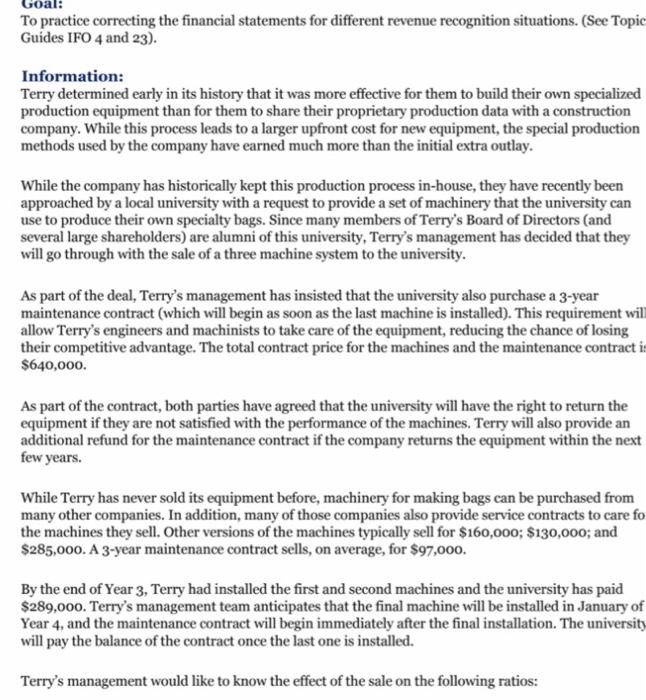Goal: To practice correcting the financial statements for different revenue recognition situations. (See Topic Guides IFO 4 and 23). Information: Terry determined early in its history that it was more effective for them to build their own specialized production equipment than for them to share their proprietary production data with a construction company. While this process leads to a larger upfront cost for new equipment, the special production methods used by the company have earned much more than the initial extra outlay. While the company has historically kept this production process in-house, they have recently been approached by a local university with a request to provide a set of machinery that the university can use to produce their own specialty bags. Since many members of Terry's Board of Directors (and several large shareholders) are alumni of this university, Terry's management has decided that they will go through with the sale of a three machine system to the university. As part of the deal, Terry's management has insisted that the university also purchase a 3-year maintenance contract (which will begin as soon as the last machine is installed). This requirement will allow Terry's engineers and machinists to take care of the equipment, reducing the chance of losing their competitive advantage. The total contract price for the machines and the maintenance contract is $640,000. As part of the contract, both parties have agreed that the university will have the right to return the equipment if they are not satisfied with the performance of the machines. Terry will also provide an additional refund for the maintenance contract if the company returns the equipment within the next few years. While Terry has never sold its equipment before, machinery for making bags can be purchased from many other companies. In addition, many of those companies also provide service contracts to care fo the machines they sell. Other versions of the machines typically sell for $160,000; $130,000; and $285,000. A 3-year maintenance contract sells, on average, for $97,000. By the end of Year 3, Terry had installed the first and second machines and the university has paid $289,000. Terry's management team anticipates that the final machine will be installed in January of Year 4, and the maintenance contract will begin immediately after the final installation. The university will pay the balance of the contract once the last one is installed. Terry's management would like to know the effect of the sale on the following ratios: 2. Make the appropriate journal entries, if any, to account for the installation of the machines (including any necessary changes to income tax expense) and the first payment by the university. Assume that the first machine cost Terry $128,000, the second $117,000, and the third $200,000. The average cost of the maintenance contract is $29,000. Terry's work building these machines has already been appropriately recorded in inventory. Please see the hints for rounding instructions for these calculations








